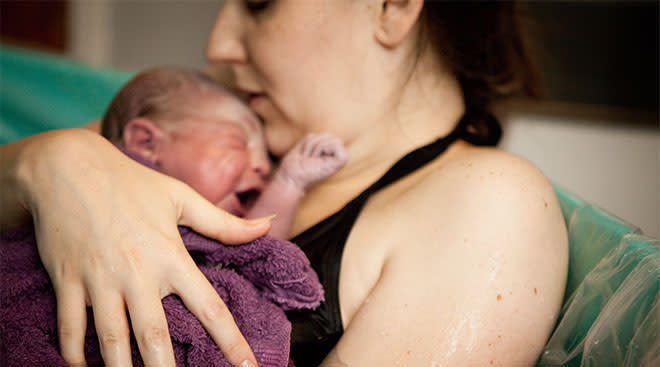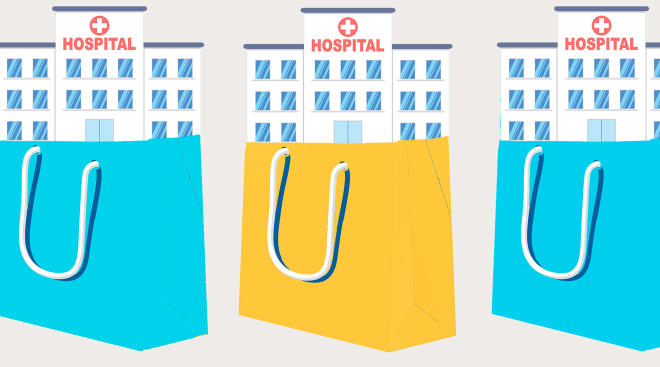A Complete Guide to Your Alternative Birth Options
For most women, giving birth anywhere outside the hospital isn’t even on their radar. After all, we’re accustomed to the notion of pregnancy, labor and delivery as a health-oriented issue, something that requires the expertise of doctors with pain-relieving meds at the ready. But really, you’ve got options. You can go the “natural” route and choose to have baby at home or at a birth center. You can do a combination, where you bring non-medicinal pain-relieving strategies, such as acupuncture needles or even a birthing tub, into the hospital. As Carolyn Campos, RN, birth center manager at Sutter Davis Hospital Birthing Center in Davis, California, reminds us: “Women shop for where they would like to give birth based on the experience they want for that birth”—and how they’d like to give birth too.
Of course, the best decision is an informed one. So read on to learn about some of the most popular alternative ways to give birth, how to decide whether it’s right for you and what you need to do to prepare for it. Whatever you decide, remember that, like doctors and medical treatments, not all alternative birthing specialists and methods are covered by insurance, so be sure to check with your carrier.
Birth centers are health care facilities that feel more like a home than a hospital. They provide women with tools that can assist them with a natural birth, such as comfortable beds with real linens, yoga mats, rocking chairs, music, aromatherapy, birthing balls, birthing tubs and on-staff doulas. Either way, each birth center has a backup plan in place should an expecting mother need to be transferred to a hospital (such as if a c-section is needed). While many centers are staffed by certified nurse midwives, some (especially those that are affiliated with hospitals) may also have ob-gyns on their team. Most women will end up delivering at the center, however. According to one study, 84 percent of women who planned to labor at a birth center ended up delivering there (4 percent were transferred to a hospital before they were even admitted to the center, and 12 percent were transferred during labor).
The ideal candidate: Someone who looks at birth as a natural process and feels comfortable not being in a hospital setting with on-site MDs and epidurals at the ready. Each center is different, so it may take some searching to find the best fit.
Not an option if: You have a high-risk pregnancy or are carrying more than one baby. You may also not be able to deliver at a birth center if you’re more than two weeks past your due date. Lastly, if you’re set on having an epidural, you may want to schedule your delivery for a hospital instead. Many centers focus on more natural forms of pain management, such as massage, breathing exercises and nitrous oxide (laughing gas), though some do use IV pain medication like fentanyl or nubain.
How to prepare: Women often end up receiving their prenatal (as well as some postnatal) care through their birth center, so you’ll want to choose your center early on in your pregnancy, if possible.
One mom’s experience: “Before I was even thinking of having kids, I watched the Rikki Lake documentary The Business of Being Born, which put the seed in my head about having a more natural birth. We found a center near us, and during the intake we were given questionnaires to fill out. I thought it was cool that they didn’t just ask about my medical history, but also how my partner and I felt emotionally about the pregnancy. All of my prenatal care was at the birth center too, and the appointments lasted about an hour. You really got to know the people who worked there—everyone was just so friendly.
The room I gave birth in felt like a bedroom, and I had the freedom to do anything I wanted: eat, drink, get in the shower. I started off in the tub, and I had a doula who rubbed my back and recommended different positions to get into to alleviate pain. The center also had a TENS unit (which offers pain relief through the use of electrical currents), which was amazing. There was one point where I was in a lot of pain and considered going to the hospital for an epidural, but my midwife said we might arrive too late to get the epidural. Once I started pushing through the contractions, though, the pain went away. Being able to move into different positions and walk around the room also helped me work through the contractions.” —Jaymi M.
Delivering at home is exactly as it sounds—you’ll give birth in your own house, with the assistance of a midwife and maybe a doula. It’s still rare in this country, with less than 1 percent of births taking place at home.
The ideal candidate: Women who feel more at ease at home and want a natural birth (meaning, no pain medication), says Julie Birdsong, RN, a certified nurse-midwife at San Francisco Birth Center. You should also be completely okay with the risks: According to the American Congress of Obstetricians and Gynecologists (ACOG), while home birth is associated with fewer maternal interventions compared to a planned hospital birth (such as for those needing labor induction and c-sections), it poses more than twice the risk for perinatal death (death within the first week of life).
Not an option if: You have a high-risk pregnancy, are carrying multiples or have a breech baby.
How to prepare: Talk to your midwife and doula about how to best set up your home for the delivery. This could include putting out clean towels to help prevent mess, making sure you have safe, comfortable locations to labor in (such as a bed, mattress on the floor, comfy couch to lean on, tub, shower or a cleared open space) and setting out items you’ll need for after baby is born (such as diapers). Most experts would also recommend taking a birthing class.
One mom’s experience: “It wasn’t until super late into my pregnancy that I decided on a home birth. People were telling me that I needed the epidural (something you can’t receive if you do a home birth), so I was nervous about that. But my midwife and doula walked me through what to expect, including the physiological process of giving birth. I knew it was all mental and that I could push through if I kept the positive outlook that my body was built to have babies.
I ended up loving giving birth at home. I really liked knowing where to go if I wanted a glass of water as well as being able to use my own shower. In fact, I used the shower for most of my labor. The hot water felt amazing. The labor was a lot worse than I expected, and at one point I did wonder if I should have opted in for drugs—but that thought quickly passed.
I thought that I’d deliver in my bed, but we set up a mattress on the floor just in case and that’s where I ended up delivering my baby. I spent most of my time there on my hands and knees, rocking back and forth to help with the pain. I can’t imagine laboring while lying down because that was such an uncomfortable position for me. Getting into the cat/cow yoga poses and wriggling my hips was what I found most comfortable.
Being in my house after giving birth was the best part. I climbed into bed and slept. A few hours later the midwife and doula returned to check on the baby and they came back a few other times during the first two weeks, which was great because I had no desire to get dressed! The process was all so comfortable and I’m so glad I was in my own space.” —Makalia H.
Hypnosis, such as the popular HypnoBirthing method, uses audio, visualization, meditation and relaxation techniques to help women manage pain during labor and delivery. “It’s like a deep meditation practice,” Birdsong says. “It’s great for stress reduction in general, even if you don’t use it during labor.” Many women bring the audio recordings into the delivery room (whether that’s at a hospital, birth center or at home) and listen throughout labor and delivery. While more research needs to be done (some studies show that hypnosis reduces the overall use of pain meds during labor, but not the use of epidurals), many moms say it’s greatly helped with their discomfort during labor.
The idea candidate: Anyone—and you don’t need to be a yogi or have prior meditation experience to give it a shot.
Not an option if: You’re close to your due date (for instance, in your last trimester). Because it takes some practice to master, experts suggest that you begin familiarizing yourself with hypnosis early on in pregnancy so you’re comfortable with the technique by the time you give birth.
How to prepare: You can attend HypnoBirthing classes, or use books or online resources to learn about the method.
One mom’s story: “I’m a yoga teacher, so the breathing and mindfulness aspects appealed to me. I watched a number of HypnoBirth videos, and I loved how calm and centered the women were. I also loved that they changed the verbiage around giving birth so that the words don’t create fear. For example, instead of saying ‘your water breaks,’ we say ‘your water releases’ and the birth canal—which sounds long and scary—is called a birth path.
I took a HypnoBirthing class when I was pregnant with my first, but to be totally honest, I didn’t master it until the second birth. The first time, I prepared by watching HypnoBirthing videos, reading the book and doing some yoga. But when it came time to labor (which took 16 hours), everything I had learned went out the window.
With my second baby I read the book again and listened to the CDs throughout my pregnancy. I also used a doula who was trained in HypnoBirthing. When I first went into labor, I listened to the meditation, which was a calm, maternal voice telling me that my baby was ready to come out. Then, when my midwife and two doulas arrived, I turned music on. It was like a mellow yoga party.
What surprised me was how quickly the birth happened. The only times I remember being uncomfortable was a point where I felt like I needed to throw up (but I never did) and when my son was crowning. But the rest felt so magical, and I don’t remember feeling anything but pressure. I wasn’t even going to allow it to be painful, which is the HypnoBirthing way—you think of it as pressure.”—Elise K., mom of two
With hydrotherapy or water immersion, women labor in tubs or Jacuzzis filled with warm water. Some women go on to deliver in the tub (known as a water birth). “The warm water helps you release tension and can also keep you relaxed during the birth,” Birdsong says.
The ideal candidate: Moms-to-be who are looking for natural pain relief may appreciate the benefits of hydrotherapy. In fact, immersion in water during the first stage of labor may be associated with a shorter labor and decreased use of epidurals. Women who choose hydrotherapy should feel comfortable being submerged in water and be able to get in and out of the tub. While the ACOG supports the use of hydrotherapy during the first stage of labor, they advise against it for delivery, stating there’s insufficient data on the benefits and risks.
Not an option if: You’re in preterm labor, are delivering a baby that needs constant monitoring (such as if you have placenta previa or a breech baby), are using an epidural or sedating medications, if you become dizzy or drowsy (only because it may become unsafe to be in the water) or if you have a blood-borne infection, such as hepatitis and HIV.
How to prepare: Locate a hospital or birth center that has a birth tub. If your hospital doesn’t have tubs available, it may be possible to rent your own portable tub; talk to your provider for recommendations.
One mom’s story: “I knew I wanted a holistic (no medication) birth pretty much from the beginning. It wasn’t until after I read more information, including a lot of books by Ina May Gaskin (aka, the “mother of authentic midwifery”) that I thought a water birth would be the right choice. I labored at home with my dogs, my husband, Tim, and my doula for around eight hours before transferring to our hospital, which was equipped with two birthing tubs.
“I waited until the last minute to get into the tub. The warm water was really the only pain relief that existed for me so I didn’t want to use it too soon. I wanted to push myself as far as I could so that the warm water would be a huge relief. And boy was it ever—it absolutely helped alleviate pain. It was like having a big heating pad on your uterus when you have bad period cramps. I felt enveloped in my very own womb of warmth. I loved the closeness I felt with my husband, who was in the tub with me. I’m sure having that closeness with my husband and the extra oxytocin floating around aided in the pain relief as well. Overall, it was a very calm and natural labor and delivery. Now that I’m pregnant again, I plan to use hydrotherapy to aid in my labor. If I end up giving birth in water again, that would be awesome, because it was so great with my first!” —Emily M.
Based on the traditional Chinese method of stimulating points on the body, acupuncture uses small needles to help labor progress and reduce pain. “The provider may be able to perform the technique themselves, but a lot of places allow an acupuncturist to come in,” says Rebecca Garrett-Brown, CNM, a certified nurse-midwife at the University of California San Diego Medical Center.
The ideal candidate: Women who want a more natural birth experience or want to avoid invasive forms of pain relief. Some research shows that using the needles can help make labor easier, while other studies show that acupressure (similar to acupuncture, but points on the body are stimulated manually rather than with needles) can reduce the need for an epidural.
Not an option if: You’re scared of needles.
How to prepare: If your provider doesn’t do acupuncture, find an acupuncturist you trust; talk to your provider about recommendations. It’s also important to follow any protocol needed to make sure the acupuncturist can be in the room during labor and delivery.
One mom’s experience: “With my first baby I had an epidural and felt terrible and groggy afterward. For my second pregnancy, I tried to go without the epidural. I knew more about birth by that point, and my good friend was my doula. But when my baby was past her due date, my doctors threatened to induce me, so I asked if I could try natural induction methods. I went to an acupuncturist twice, and it worked!
The needles are so tiny and were inserted in my back and feet. I wasn’t sure what to expect, but when the first needle went in I realized that you couldn’t even feel it. What I did feel was parts of my body reacting to the acupuncture placement (like having a needle inserted in my foot and feeling a slight contraction in my belly). That was fascinating! My acupuncturist also came to the hospital with me but in the end I had to have another epidural because my baby was stuck and I ended up having back labor.
With my third child, I knew what I wanted, so we used acupuncture not only to help me go into labor (which didn’t end up working this time around), but also in the hospital as pain management. I’ve learned that with contractions and pushing, you’re supposed to have some level of pain—that’s normal. But with the acupuncture it felt manageable. I never thought, ‘Oh, I can’t do this!’ It helped me get through each contraction and the pushing.” —Leigh Anne O.
Published December 2017
Navigate forward to interact with the calendar and select a date. Press the question mark key to get the keyboard shortcuts for changing dates.




















































